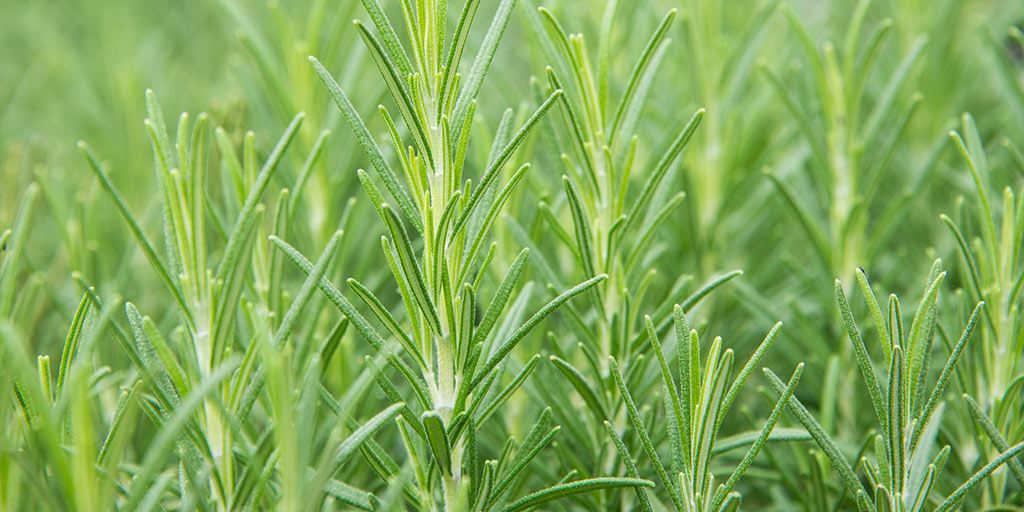Beth Sears is a freelance writer and grows small fruits, vegetables and herbs in her Midwestern garden.
Growing Rosemary
A must-have herb, rosemary (Rosmarinus officinalis) is a perennial evergreen shrub with very aromatic foliage that perfumes the summer air. The herb is a culinary favorite for seasoning lamb, poultry, soups and stews. When dried, it’s often added to sachets and potpourri and used in teas. Some believe it enhances the memory.
A native of the Mediterranean region, rosemary is winter hardy in zones 8-10, where it grows into a 3-6 ft., ornamental woody shrub with needle-like, gray-green leaves and blue flowers. In zones 7 and colder, it reaches 2-3 ft. tall and can be grown as an annual or grown in a pot and brought indoors during the winter months. When growing indoors, make sure it gets plenty of light, or use a grow light. Rosemary performs best in full sun and well-drained sandy soils that are medium to dry.
Below are more tips for planting and harvesting this easy-to-grow herb.
How to Plant Rosemary
While rosemary can be grown from seed, germination rates are low. Most gardeners either propagate rosemary from cuttings, or they buy small plants and transplant them to the garden.
If propagating from cuttings, cut stems and strip the leaves on the bottom of the cutting. Cuttings can be placed in peat moss and kept moist until roots have developed.
Here’s how to plant rosemary:
- Plant rosemary plants in late spring when all danger of frost has passed.
- Rosemary grows best in full sun (at least six hours of direct sunlight daily) and in well-drained, sandy soils with a pH close to neutral. Mixing compost into the soil improves drainage. Select a location where the plants will also receive plenty of air circulation. Northern gardeners should space plants 2-3 ft. apart while Southern gardens should space plants 3-4 ft. Avoid overcrowding rosemary. After planting, water well.
- If growing rosemary in a pot, use a quality potting soil and plant in a terra cotta pot, which dries out quicker than containers made of other materials. Water at regular intervals.
- Once rosemary is established, rosemary plant care is easy. Pruning or harvesting helps keep the plant bushy. Rosemary seldom needs fertilizer. If fertilizing, use a slow-release, all-natural fertilizer. Avoid overwatering.
Best Rosemary Growing Conditions
This Mediterranean native prefers lots of sun—at least six hours of direct sunlight daily, warm temperatures and humid conditions. Rosemary grows best in well-drained soils and is drought tolerant, once established. Make sure it also receives plenty of air circulation.
Replicating these growing conditions indoors can be a challenge. When growing indoors, make sure the rosemary plant receives plenty of light, or use a grow light. Avoid placing the plant in areas that are drafty. Make sure the container you use has good drainage and avoid overwatering. Terra cotta pots are ideal because they allow the soil to dry out more quickly.
When pruning or harvesting rosemary, take no more than one-third of the plant. This allows for regrowth.
How to Harvest Rosemary
Use scissors, pruning shears or a sharp knife to harvest rosemary. Make the cuts right above a pair of leaves. For the best taste, harvest the young stems and leaves. Never take more than one-third of the plant during a harvest.
Rosemary is easy to dry. Cut the stems and tie several stems together with twine or rubber bands. Hang the stems in a dry, dark, well-ventilated room for 10 days. Rosemary can also be oven-dried or dried in a dehydrator. After dried, rosemary can be stored in airtight containers at room temperature. For the best flavor, use dried rosemary within a year.
When to Harvest Rosemary
Rosemary can be harvested when the plant’s roots are established, and it is actively growing. In Southern areas where rosemary grows year-round, it can be harvested in the spring. If you plant young rosemary plants in the garden in the spring, wait until summer to harvest it. Stop harvesting in the fall, about two weeks before the frost date.
How to Store Rosemary
Fresh rosemary can be stored in the refrigerator for up to 1-2 weeks. Dried rosemary can be stored in airtight containers. Rosemary can also be frozen.
Rosemary can also be infused in olive oil and stored in the refrigerator for up to three months. When infused with vinegar, it can be stored in the refrigerator for up to six months.
How to Use Rosemary
Rosemary has a distinctive, piney taste and has many culinary uses. It pairs well with lamb, pork, chicken, potatoes, soups and sauces—or it can be blended with other herbs for salads and seasoning. Infusing olive oil and vinegars with rosemary is a great way to season foods. For a wonderful flavor sensation, mix with other herbs and butter for herbed butter. When the sprigs are left whole, rosemary makes an attractive garnish. Some say rosemary tea boosts the memory. Here’s how to make your own herbal tea.
Because the leaves are very aromatic, rosemary sprigs can be used in fresh floral bouquets or in sachets.
In the garden, rosemary is excellent for ornamental plantings. These low-growing shrubs can be planted along walkways or grown in groups as a low hedge.
With its many culinary uses, aromatic foliage and good looks, rosemary is an herb worth growing in the sunny garden or containers. Gurney’s offers both herb seeds and plants for sale. Order yours today and start growing rosemary in your sunny garden.
Rosemary FAQs
- Does Rosemary Need Full Sun?
Rosemary performs best in full sun, or at least six hours of direct sunlight daily. It likes afternoon sun. - How Big Does Rosemary Grow?
When grown in zones 8-10, rosemary can grow 5 ft. tall. In zones 7 and cooler, it typically grows 2-3 ft. tall. - How Fast Does Rosemary Grow?
While rosemary is slow to germinate and to get established, it grows well in warm temperatures and after its roots are established. - What Grows Well With Rosemary?
Rosemary is a great addition to herb gardens and sun-filled flower gardens. In the vegetable garden, it’s often planted near broccoli, cabbage, and other members of the cabbage family because it repels some insect pests.

